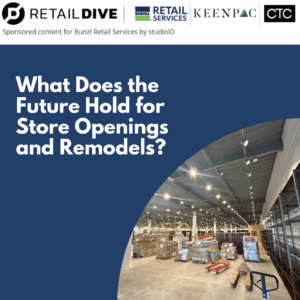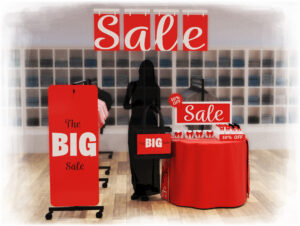
Supply Chain Now Podcast Feature with VP of Operations and Logistics
The importance of “knowing how to fail,” advice on starting a career in supply chain management, BRS’s culture and more.
Marie Hurst, Vice President of Operations and Logistics at Bunzl Retail Services, has decades of experience working with well-known brands such as Macy’s and Carters. She recently talked with Scott Luton, founder and CEO of the Supply Chain Now podcast, where she provided some great career advice and insights.
Here are some key takeaways from their conversation, or you can listen to the full podcast here.
· What are the biggest challenges in retail supply chain management?
· Reverse logistics: what is it and where is it going?
· A day in the life of the VP of Ops and Supply Chain Management
· How to begin a career in supply chain management
· Rising up in your supply chain and logistics career
· “Learning to fail”
The Biggest Challenges in Retail Supply Chain Management
When asked about the biggest challenges in the retail supply chain industry, Marie says that “There are a lot of competing priorities that are often conceptually counter-intuitive to each other.”
“As an example: a product is planned and committed six months to a year ahead of actual delivery to the store. Because you have to produce it, get the raw materials for it, make it—often in another country—you have to plan that transit. You have to do any value-added services, and then get it to the store.”
While many of the trends flow seamlessly year over year, there is also the other side, which is the rushed competition of trends and hot products.
“You may suddenly get a request to move multiple containers or truckloads of something from a place never previously covered. And it has to happen right away because some other retailer is trying to get their hands on the same product and there is only X amount.”
Marie explains this work is often a combination of standard, daily tasks and those rushed, frantic requests.
Reverse Logistics
“Return and reverse logistics are a big piece of retail and have always been, even prior to how we’ve seen so much growth with online shopping over the past several years.”
The global reverse logistics market size was valued at $840 billion in 2021 and is expected to expand at a compound annual growth rate of 12.4% from 2022 to 2028, according to Grandview Research.
What is reverse logistics and how does it work? Marie sheds some light on the process.
“Retailers generally try to have a return agreement with the vendors upfront as part of the purchase agreement. But they can’t always negotiate that. So often after you see something on a clearance rack, it’s been marked down two or three times, then it will have to go back to logistics to deal with.” This type of reverse logistics is something most brands or retailers try to avoid.
But reverse logistics isn’t simply returning items to manufacturers or retailers. White glove service providers will manage the surplus items and find a way to resell, reuse, or recycle the items.
An example of this is Bunzl Retail Services’ initiative with Safety Kleen to turn waste into fuel for our clients to promote more sustainable waste disposal. They recently disposed of 300,000 lbs. of sanitizer and incinerated over 1.7 million pounds of wipes in a process that powers a concrete kiln.
“Generally, you’re trying to liquidate. Some of it will end up in an off-price store in the U.S. or shipped overseas. You really don’t want to throw it in a dumpster, you want to find some end-of-life reuse wherever possible.
“We’re seeing a lot of innovation on the reverse side. Especially if it’s a customer return and it’s resalable,” says Hurst. Advanced data platforms such as Software as a Service SaaS platforms and online auctions have opened new options and made the process cheaper and simpler.
Software as a Service (SaaS) platforms can use sophisticated data analysis to automatically decide the best channel for returned items. Decisions such as whether to refurbish, reroute, liquidate, or scrap returned products can be assigned by the software based on historical data and other information updated in real-time, notes ConsumerReturns.com.
Bunzl Retail Services’ Focus
Bunzl has separate divisions that manage grocery, food processors, c-store and more. “We’re doing a lot more of the smaller, niche, or value-added services type services for our retail partners.”
Some of these value-added services include new store openings, store closures, remodels and materials kitting and consolidation.
“Most of what we’re doing is distribution. We have a subdivision within retail services that designs custom packaging and visual displays and then materials consolidation.
“An example would be if you have a new store and you don’t want to just spam that location with all the supplies from different display companies, cleaning supplies and so forth. We have a service where we can consolidate it all, build out pallets, and then release it to you in time for your opening,” Marie continues.
A Day in the Life of the VP of Operations and Logistics
Marie notes that she spends most of her time on the road and a lot of time working closely with engineers.
“We’re trying to do a lot of work on continuous improvement and growing our facilities to be more efficient.” She notes the increasing challenges with the cost of labor rising being one factor driving the need to constantly evolve.
“Distribution is down and dirty, but we’re looking at how we can make it more effective and efficient.”
“We’re trying to be really thoughtful and methodical about the way we layout the buildings. Thinking about where we can put in sorters, we’re looking at pick carts. We’re talking with 6 River Systems to see if we can do a pilot with them for some of our pick-pack areas.”
6 River Systems utilizes mobile robots to automate the process of warehouse fulfillment with cloud-based software. Their process is said to boost productivity 2-3x on average.
Bunzl Retail Services Safety and Culture
“There’s a very robust safety culture,” says Marie as she shares an example of how the team recently completed the Caterpillar safety module. The operations and logistics team level set what their practices are and what best practices should look like through conversations with the Caterpillar team.
“For me, it’s not about ‘having a safety moment’ which is a catchphrase. It’s what’s your safety momentum?”
“What I love about my role is that I have some really strong team members with me. We are vocal and open, and we bring things to the surface. I try not to lead a political sphere. I don’t want you to tell me what you think I want to hear. Let’s air it out. Let’s get the best of everybody’s ideas and percolate the best solution.
Host Scott Luton adds how he’s experienced less-than-ideal work cultures and adds that these overly political environments can be stifling to new ideas.
At Bunzl Retail Services, “There is a culture where there is more ability to have your voice heard and to be impactful,” observes Marie.
Starting a Career in Supply Chain Management
The U.S. supply chain accounts for 37% of all domestic jobs, according to the Harvard Business Review. The majority of supply chain management positions are open to those with a bachelor’s degree and do not require a master’s degree.
When it comes to beginning a career in supply chain management or logistics, Marie’s advice is:
“Look for internship opportunities or summer jobs. Once you have your foot in the door somewhere, try to be the one that stands out because you take things other people don’t want to do.”
Rising Up in Your Supply Chain Management or Logistics Career
Marie shares that oftentimes in her career several team members may have all wanted to go after the same role or promotion. Instead of being one of a handful of employees going after a singular role, maybe there’s another role with less competition you should consider. You can still make an impact while possibly learning a new skill.
She also emphasizes the importance of being the one to raise your hand for new opportunities and be willing to try something you may not be familiar with.
“Be the one to say, ‘I’ll do it.’ I didn’t always want to do it, but I learned something every time to the point where they started coming to me and saying, ‘We want you to come do this.’
“Becoming well-rounded like that is critical to rising up. Because you have to know enough about enough to be able to supervise it all.”
Knowing How to Fail
Of course, when someone jumps into a new endeavor or undertakes different responsibilities there is a learning curve and the potential for failure.
“There have been times when I jumped into something and thought wow, this is ugly and painful,” Marie admits. However, “Knowing it’s okay to fail is crucial.”
Luton agrees, “I think the highest performing cultures that really are truly innovative in a real action-oriented manner are those that tolerate and encourage failure much more than others.”
Marie mused that it’s critical because:
“If I’m not allowed to fail then I’m less likely to try.”
“But the other important piece to understand is that when you do fail, you should walk away learning something.”
It’s important to not be afraid to take a step back and ask questions. Scott adds, “Sometimes it can be awkward or painful to be that person to call a time out and level set but it’s absolutely critical.”
After becoming a Six Sigma Black Belt, Marie honed her decision-making skills even further and was able to ask those crucial questions such as:
“What are your priorities and how do you support that with data—not emotions.”
She further explains that when a team is brainstorming or working through a problem, it’s important to go back and revisit the original goal and ask “What are we trying to accomplish? Does this solve the original problem?”
This insightful advice is helpful in almost any role or industry, whether you are just beginning your career or are a seasoned pro. Share this article on social and let us know what resonated most with you.
To hear more about Marie’s background, listen to the full Supply Chain Now podcast here.
To learn more about our retail operations services, reverse logistics, or how we can help your organization operate more efficiently, contact us.
Written June 22, 2022 by Bunzl Retail Services staff writers.




